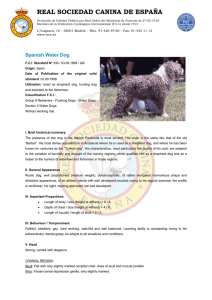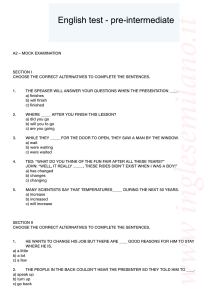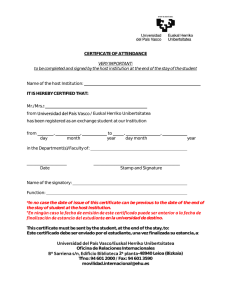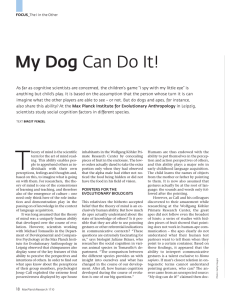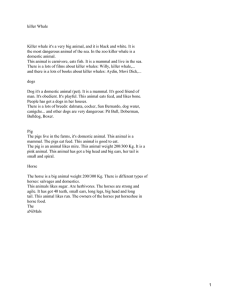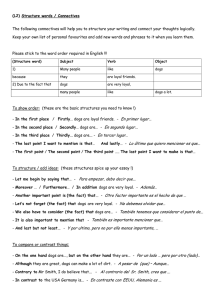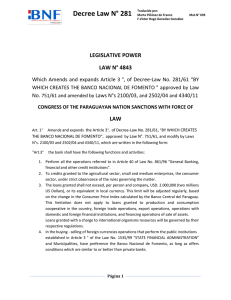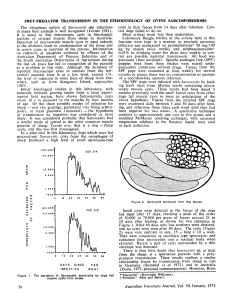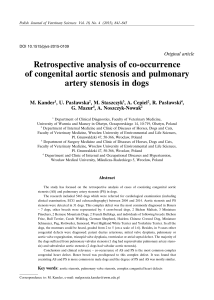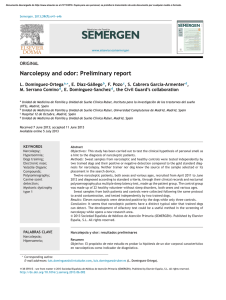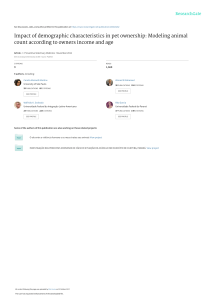REAL SOCIEDAD CANINA DE ESPAÑA
Anuncio
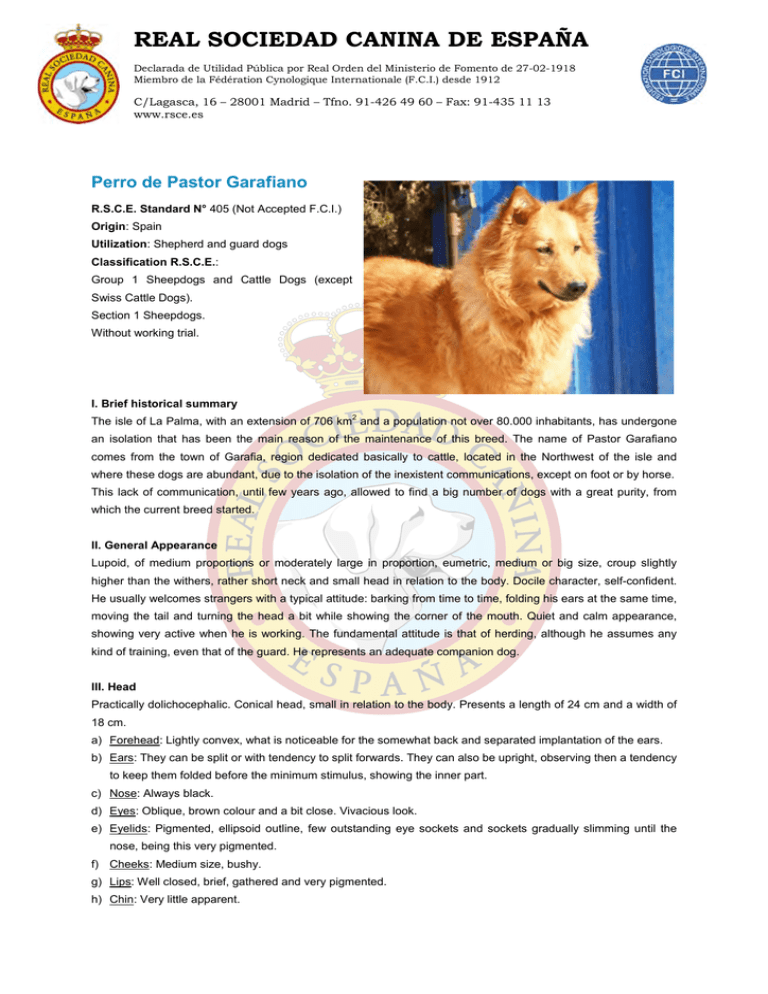
REAL SOCIEDAD CANINA DE ESPAÑA Declarada de Utilidad Pública por Real Orden del Ministerio de Fomento de 27-02-1918 Miembro de la Fédération Cynologique Internationale (F.C.I.) desde 1912 C/Lagasca, 16 – 28001 Madrid – Tfno. 91-426 49 60 – Fax: 91-435 11 13 www.rsce.es Perro de Pastor Garafiano R.S.C.E. Standard N° 405 (Not Accepted F.C.I.) Origin: Spain Utilization: Shepherd and guard dogs Classification R.S.C.E.: Group 1 Sheepdogs and Cattle Dogs (except Swiss Cattle Dogs). Section 1 Sheepdogs. Without working trial. I. Brief historical summary 2 The isle of La Palma, with an extension of 706 km and a population not over 80.000 inhabitants, has undergone an isolation that has been the main reason of the maintenance of this breed. The name of Pastor Garafiano comes from the town of Garafia, region dedicated basically to cattle, located in the Northwest of the isle and where these dogs are abundant, due to the isolation of the inexistent communications, except on foot or by horse. This lack of communication, until few years ago, allowed to find a big number of dogs with a great purity, from which the current breed started. II. General Appearance Lupoid, of medium proportions or moderately large in proportion, eumetric, medium or big size, croup slightly higher than the withers, rather short neck and small head in relation to the body. Docile character, self-confident. He usually welcomes strangers with a typical attitude: barking from time to time, folding his ears at the same time, moving the tail and turning the head a bit while showing the corner of the mouth. Quiet and calm appearance, showing very active when he is working. The fundamental attitude is that of herding, although he assumes any kind of training, even that of the guard. He represents an adequate companion dog. III. Head Practically dolichocephalic. Conical head, small in relation to the body. Presents a length of 24 cm and a width of 18 cm. a) Forehead: Lightly convex, what is noticeable for the somewhat back and separated implantation of the ears. b) Ears: They can be split or with tendency to split forwards. They can also be upright, observing then a tendency to keep them folded before the minimum stimulus, showing the inner part. c) Nose: Always black. d) Eyes: Oblique, brown colour and a bit close. Vivacious look. e) Eyelids: Pigmented, ellipsoid outline, few outstanding eye sockets and sockets gradually slimming until the nose, being this very pigmented. f) Cheeks: Medium size, bushy. g) Lips: Well closed, brief, gathered and very pigmented. h) Chin: Very little apparent. REAL SOCIEDAD CANINA DE ESPAÑA Declarada de Utilidad Pública por Real Orden del Ministerio de Fomento de 27-02-1918 Miembro de la Fédération Cynologique Internationale (F.C.I.) desde 1912 C/Lagasca, 16 – 28001 Madrid – Tfno. 91-426 49 60 – Fax: 91-435 11 13 www.rsce.es i) Mouth: The teeth present certain variability, finding dogs with a larger or smaller number of teeth than usual. Scissor bite in order to avoid injuries to the cattle. j) Nape: Little marked. k) Stop: Soft and little pronounced. IV. Neck Short, with a well-muscled upper line. Very bushy as a whole, especially on the throat. He does not have dewlap. V. Trunk Wide dorsal-sternal diameter, with a bit arched ribs and great thoracic capacity. a) Withers: Muscled, in a slightly lower plan than the croup, provoking a dorsal-lumbar straight and lightly rising towards the sacrum line. b) Loin: Well muscled although lightly narrow. The tip of the haunch, as well as that of the buttock, is not excessively outstanding, forming a hip with a soft outline. c) Flanks: Short, lightly muscled and well marked, presenting a drawn up, making the groin be deep. d) Genital system: In proportion to the rest of the body, with a bushy prepuce. VI. Tail Bushy, sabre rail or lightly or slightly rolled, but never on the loin. Its length does not usually surpass the hock joint. VII. Limbs Forequarters a) General Appearance: Large and muscled back, the same as the arm. b) Arm: Oblique. c) Articulations of the shoulder and the elbow: Very strong. d) Forearm: Perpendicular to the floor. e) Carpus (Carpal joint): Follows the vertical line of the forearm. f) Metacarpus (Pastern): Very inclined forwards. g) Hand: Oval, toes tight and strong, curved and pigmented nails, the same as the plantar pads. Lack of dewclaws. Hindquarters a) Upper thigh: Wide and well muscled. Slightly convex buttock. b) Knee: Placed in the imaginary line that joins the tip of the haunch vertically with the floor. c) Leg: Long and muscled. Wide and tight hock joint. d) Metatarsus: Sturdy, lean and absolutely vertical. e) Foot: As well as in the forequarters, characteristic “harefeet”. Presence or not of dewclaws. REAL SOCIEDAD CANINA DE ESPAÑA Declarada de Utilidad Pública por Real Orden del Ministerio de Fomento de 27-02-1918 Miembro de la Fédération Cynologique Internationale (F.C.I.) desde 1912 C/Lagasca, 16 – 28001 Madrid – Tfno. 91-426 49 60 – Fax: 91-435 11 13 www.rsce.es VIII. Hair Bushy, longer or not, soft texture in some cases and a bit rough in others, accumulated mainly on the base of the ears, neck, featherings, tail, rear edge of the forequarters and between the toes. Smooth on the muzzle, forehead, front part of the fore- and hindquarters, on the hock joint downwards. IX. Colour Fawn or greyish coat, in his different shades. Very clear fawn can be mistaken for wafer colour. Exceptionally black or brownish-gray dogs can be seen. Puppies are brownish, but this colour changes when they are adults, and in some of them there appear hairs or little white spots on the chest, toes of tip of the tail that tend to disappear when they grow up. X. Size and Weight Height at the withers: Males: 57 to 64 cm. Females: 55 to 62 cm. The croup always measures from 1 to 3 cm. more. Weight: Males: 28 to 35 kg. Females: 24 to 30 kg. There exist dogs of higher or lower weights and measures, due to hybridizations or an inadequate care.
